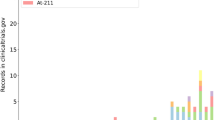Abstract
In modern radiation oncology, tolerance dose-constraints for organs at risk (OAR) must be considered for treatment planning, but particularly in order to design clinical studies. Tolerance dose tables, however, only address one aspect of the therapeutic ratio of any clinical study, i.e., the limitation of adverse events, but not the desired potential improvement in the tumor effect of a novel treatment strategy. A sensible application of “tolerance doses” in a clinical situation requires consideration of various critical aspects addressed here: definition of tolerance dose, specification of an endpoint/symptom, consideration of radiation quality and irradiation protocol, exposed volume and dose distribution, and patient-related factors of radiosensitivity.
The currently most comprehensive estimates of OAR radiation tolerance are in the QUANTEC compilations (2010). However, these tolerance dose values must only be regarded as a rough orientation and cannot answer the relevant question for the patients, i.e., if the study can achieve a therapeutic advantage; this can obviously be answered only by the final scientific analysis of the study results. Despite all limitations, the design of clinical studies should currently refer to the QUANTEC values for appreciation of the risk of complications, if needed supplemented by one’s own data or further information from the literature.
The implementation of a consensus on the safety interests of the patients and on an application and approval process committed to progress in medicine, with transparent quality-assuring requirements with regard to the structural safeguarding of the study activities, plays a central role in clinical research in radiation oncology.
Zusammenfassung
In der modernen Radioonkologie müssen Toleranzdosisgrenzen für die Risikoorgane („organs at risk“, OAR) zur Behandlungsplanung, besonders aber zur Gestaltung klinischer Studien, herangezogen werden. Jedoch sind Toleranzdosistabellen als Basis zur Bewertung einer klinischen Studie grundsätzlich dadurch limitiert, dass sie nur einen Parameter des therapeutischen Verhältnisses der Behandlung berücksichtigen, nämlich unerwünschte Nebenwirkungen, nicht aber die erwünschte potentielle Verbesserung der Tumorwirkung. Die sinnvolle Anwendung von „Toleranzdosen“ in der Klinik bedarf der Berücksichtigung verschiedener kritischer Aspekte, die in diesem Artikel angesprochen werden: die Definition der Toleranzdosis, die Festlegung eines Endpunkts/Symptoms, die Berücksichtigung von Strahlenqualität und Bestrahlungsprotokoll, exponiertem Volumen und Dosisverteilung sowie patientenbezogene Faktoren der Normalgewebsempfindlichkeit.
Die derzeit umfassendste Abschätzung der OAR-Toleranz findet sich in der Zusammenstellung von QUANTEC (2010). Die dort gelisteten Toleranzwerte sind jedoch grundsätzlich nur als Orientierungshilfe zu betrachten und können nicht die für den Patienten relevante Frage beantworten, ob mit einer klinischen Studie ein therapeutischer Vorteil erreicht werden kann; dies kann naturgemäß nur durch die abschließende wissenschaftliche Auswertung der Studienergebnisse erfolgen. Trotz aller Einschränkungen sollten bei der Gestaltung klinischer Studien die Werte von QUANTEC zur Bewertung des Komplikationsrisikos herangezogen werden, falls möglich ergänzt durch eigene Daten und neuere Ergebnisse aus dem Schrifttum.
Eine Konsensbildung über ein den Sicherheitsinteressen der Patienten und gleichzeitig dem medizinischen Fortschritt verpflichtetes Antrags- und Genehmigungsverfahren mit transparenten qualitätssichernden Anforderungen an die strukturelle Absicherung der Studienabläufe ist von zentraler Wichtigkeit für die klinische Forschung in der Radioonkologie.
Similar content being viewed by others
References
Emami B, Lyman J, Brown A et al (1991) Tolerance of normal tissue to therapeutic irradiation. Int J Radiat Oncol Biol Phys 21:109–122
Marks LB, Ten Haken RK, Martel MK (2010) Guest editor's introduction to QUANTEC: A users guide. Int J Radiat Oncol Biol Phys 76 (Suppl):S1–S2
Bentzen SM, Dörr W, Gahbauer R et al (2012) Bioeffect modeling and equieffective dose concepts in radiation oncology—terminology, quantities and units. Radiother Oncol 105:266–268
Joiner MC, Bentzen SM (2009) Fractionation: the linear-quadratic approach. In: Joiner M, Van der Kogel A (eds) Basic Clinical Radiobiology, 4th Edition, Ch. 8. Hodder Arnold, London. pp 102–119
Thames HD, Bentzen SM, Turesson I et al (1989) Fractionation parameters for human tissues and tumors. Int J Radiat Biol 56:701–710
Dörr W (2009) Time factors in normal tissue responses to irradiation. In: Joiner M, Van der Kogel A (eds) Basic Clinical Radiobiology, 4th Edition, Ch 11. Hodder Arnold, London. pp 149–157
Dörr W, Hendry JH (2001) Consequential late effects in normal tissues. Radiother Oncol 61:223–231
Dörr W (2009) Pathogenesis of normal tissue side effects. In: Joiner M, Van der Kogel A (eds) Basic Clinical Radiobiology, 4th Edition, Ch 13. Hodder Arnold, London. pp 169–190
Dörr W, Weber-Frisch M (1995) Effects of changing weekly dose on accelerated repopulation during fractionated irradiation of mouse tongue mucosa. Int J Radiat Biol 67:577–585
Dörr W (2003) Modulation of repopulation processes in oral mucosa: experimental results. Int J Radiat Biol 79:531–537
Gregoire V, Baumann M (2009) Combined radiotherapy and chemotherapy. In: Joiner M, Van der Kogel A (eds) Basic Clinical Radiobiology, 4th Edition, Ch. 18. Hodder Arnold, London. pp 246–258
Niyazi M, Maihoefer C, Krause M et al (2011) Radiotherapy and “new” drugs-new side effects? Radiat Oncol 6:177
Duma MN, Kampfer S, Schuster T et al (2012) Adaptive radiotherapy for soft tissue changes during helical tomotherapy for head and neck cancer. Strahlenther Onkol 188:243–247
Duma MN, Schuster T, Aswathanarayana N et al (2013) Localization and quantification of the delivered dose to the spinal cord. Predicting actual delivered dose during daily MVCT image-guided tomotherapy. Strahlenther Onkol 189:1026–1031
Hüttenrauch P, Witt M, Wolff D et al (2014) Target volume coverage and dose to organs at risk in prostate cancer patients: dose calculation on daily cone-beam CT data sets. Strahlenther Onkol, Epub ahead of print 16 Jan 2014
Georg P, Boni A, Ghabuous A et al (2013) Time course of late rectal- and urinary bladder side effects after MRI-guided adaptive brachytherapy for cervical cancer. Strahlenther Onkol 189:535–540
Mazeron R, Gilmore J, Champoudry J et al (2014) Volumetric evaluation of an alternative bladder point in brachytherapy for locally advanced cervical cancer. Strahlenther Onkol 190:41–44
Marks LB, Yorke ED, Jackson A et al (2010) Use of normal tissue complication probability models in the clinic. Int J Radiat Oncol Biol Phys 76(Suppl):S10–S19
Mehta V (2005) Radiation pneumonitis and pulmonary fibrosis in non-small-cell lung cancer: pulmonary function, prediction, and prevention. Int J Radiat Oncol Biol Phys 63:5–24
Seppenwoolde Y, De Jaeger K, Boersma LJ et al (2004) Regional differences in lung radiosensitivity after radiotherapy for non-small-cell lung cancer. Int J Radiat Oncol Biol Phys 60:748–758
Bijl HP, van Luijk P, Coppes RP et al (2005) Regional differences in radiosensitivity across the rat cervical spinal cord. Int J Radiat Oncol Biol Phys 61:543–551
Bijl HP, van Luijk P, Coppes RP et al (2006) Influence of adjacent low-dose fields on tolerance to high doses of protons in rat cervical spinal cord. Int J Radiat Oncol Biol Phys 64:1204–1210
Ghobadi G, van der Veen S, Bartelds B et al (2012) Physiological interaction of heart and lung in thoracic irradiation. Int J Radiat Oncol Biol Phys 84:e639–646
Dörr W, Hagen U, Eckardt-Schupp F (2004) Strahlungen. In: Marquardt H, Schäfer SG (eds) Lehrbuch der Toxikologie. Wissenschaftliche Verlagsgesellschaft mbH, Stuttgart
Thurner EM, Krenn-Pilko S, Langsenlehner U et al (2014) Association of genetic variants in apoptosis genes FAS and FASL with radiation-induced late toxicity after prostate cancer radiotherapy. Strahlenther Onkol Epub ahead of print 16 Jan 2014
Herrmann T, Baumann M, Dörr W (2006) Klinische Strahlenbiologie—kurz und bündig, 4th edn., Elsevier, München
Holthusen H (1936) Erfahrungen über die Verträglichkeitsgrenze für Röntgenstrahlen und deren Nutzanwendung zur Verhütung von Schäden. Strahlenther 57:254–268
Acknowledgments
This project was supported by the board of the German Society for Radiation Oncology (DEGRO, www.degro.org).
Author information
Authors and Affiliations
Corresponding author
Rights and permissions
About this article
Cite this article
Dörr, W., Herrmann, T. & Baumann, M. Application of organ tolerance dose-constraints in clinical studies in radiation oncology. Strahlenther Onkol 190, 621–627 (2014). https://doi.org/10.1007/s00066-014-0613-5
Received:
Accepted:
Published:
Issue Date:
DOI: https://doi.org/10.1007/s00066-014-0613-5




